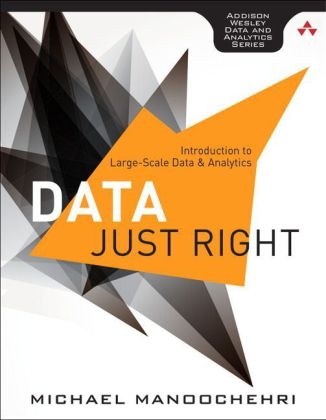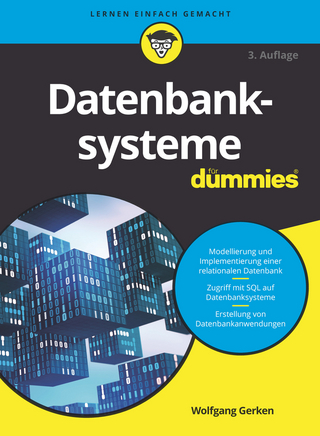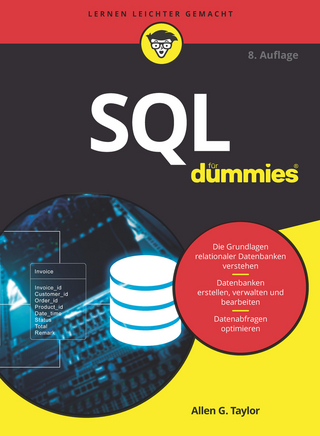
Data Just Right
Addison-Wesley Educational Publishers Inc (Verlag)
978-0-321-89865-4 (ISBN)
- Titel ist leider vergriffen;
keine Neuauflage - Artikel merken
Large-scale data analysis is now vitally important to virtually every business. Mobile and social technologies are generating massive datasets; distributed cloud computing offers the resources to store and analyze them; and professionals have radically new technologies at their command, including NoSQL databases. Until now, however, most books on “Big Data” have been little more than business polemics or product catalogs. Data Just Right is different: It’s a completely practical and indispensable guide for every Big Data decision-maker, implementer, and strategist.
Michael Manoochehri, a former Google engineer and data hacker, writes for professionals who need practical solutions that can be implemented with limited resources and time. Drawing on his extensive experience, he helps you focus on building applications, rather than infrastructure, because that’s where you can derive the most value.
Manoochehri shows how to address each of today’s key Big Data use cases in a cost-effective way by combining technologies in hybrid solutions. You’ll find expert approaches to managing massive datasets, visualizing data, building data pipelines and dashboards, choosing tools for statistical analysis, and more. Throughout, the author demonstrates techniques using many of today’s leading data analysis tools, including Hadoop, Hive, Shark, R, Apache Pig, Mahout, and Google BigQuery.
Coverage includes
Mastering the four guiding principles of Big Data success—and avoiding common pitfalls
Emphasizing collaboration and avoiding problems with siloed data
Hosting and sharing multi-terabyte datasets efficiently and economically
“Building for infinity” to support rapid growth
Developing a NoSQL Web app with Redis to collect crowd-sourced data
Running distributed queries over massive datasets with Hadoop, Hive, and Shark
Building a data dashboard with Google BigQuery
Exploring large datasets with advanced visualization
Implementing efficient pipelines for transforming immense amounts of data
Automating complex processing with Apache Pig and the Cascading Java library
Applying machine learning to classify, recommend, and predict incoming information
Using R to perform statistical analysis on massive datasets
Building highly efficient analytics workflows with Python and Pandas
Establishing sensible purchasing strategies: when to build, buy, or outsource
Previewing emerging trends and convergences in scalable data technologies and the evolving role of the Data Scientist
Michael Manoochehri is an entrepreneur, writer, and optimist. With many years of experience working with enterprise, research, and non-profit organizations, his goal is to help make scalable data analytics more affordable and accessible. Michael has been a member of Google's Cloud Platform developer relations team, focusing on cloud computing and data developer products such as Google BigQuery. In addition, Michael has written for the tech blog ProgrammableWeb.com, has spent time in rural Uganda researching mobile phone use, and holds a master's degree in information management and systems from UC Berkeley's School of Information.
Foreword xv
Preface xvii
Acknowledgments xxv
About the Author xxvii
Part I: Directives in the Big Data Era 1
Chapter 1: Four Rules for Data Success 3
When Data Became a BIG Deal 3
Data and the Single Server 4
The Big Data Trade-Off 5
Anatomy of a Big Data Pipeline 9
The Ultimate Database 10
Summary 10
Part II: Collecting and Sharing a Lot of Data 11
Chapter 2: Hosting and Sharing Terabytes of Raw Data 13
Suffering from Files 14
Storage: Infrastructure as a Service 15
Choosing the Right Data Format 16
Character Encoding 19
Data in Motion: Data Serialization Formats 21
Summary 23
Chapter 3: Building a NoSQL-Based Web App to Collect Crowd-Sourced Data 25
Relational Databases: Command and Control 25
Relational Databases versus the Internet 28
Nonrelational Database Models 31
Leaning toward Write Performance: Redis 35
Sharding across Many Redis Instances 38
NewSQL: The Return of Codd 41
Summary 42
Chapter 4: Strategies for Dealing with Data Silos 43
A Warehouse Full of Jargon 43
Hadoop: The Elephant in the Warehouse 48
Data Silos Can Be Good 49
Convergence: The End of the Data Silo 51
Summary 53
Part III: Asking Questions about Your Data 55
Chapter 5: Using Hadoop, Hive, and Shark to Ask Questions about Large Datasets 57
What Is a Data Warehouse? 57
Apache Hive: Interactive Querying for Hadoop 60
Shark: Queries at the Speed of RAM 65
Data Warehousing in the Cloud 66
Summary 67
Chapter 6: Building a Data Dashboard with Google BigQuery 69
Analytical Databases 69
Dremel: Spreading the Wealth 71
BigQuery: Data Analytics as a Service 73
Building a Custom Big Data Dashboard 75
The Future of Analytical Query Engines 82
Summary 83
Chapter 7: Visualization Strategies for Exploring Large Datasets 85
Cautionary Tales: Translating Data into Narrative 86
Human Scale versus Machine Scale 89
Building Applications for Data Interactivity 90
Summary 96
Part IV: Building Data Pipelines 97
Chapter 8: Putting It Together: MapReduce Data Pipelines 99
What Is a Data Pipeline? 99
Data Pipelines with Hadoop Streaming 101
A One-Step MapReduce Transformation 105
Managing Complexity: Python MapReduce Frameworks for Hadoop 110
Summary 114
Chapter 9: Building Data Transformation Workflows with Pig and Cascading 117
Large-Scale Data Workflows in Practice 118
It’s Complicated: Multistep MapReduce
Transformations 118
Cascading: Building Robust Data-Workflow Applications 122
When to Choose Pig versus Cascading 128
Summary 128
Part V: Machine Learning for Large Datasets 129
Chapter 10: Building a Data Classification System with Mahout 131
Can Machines Predict the Future? 132
Challenges of Machine Learning 132
Apache Mahout: Scalable Machine Learning 136
MLBase: Distributed Machine Learning
Framework 139
Summary 140
Part VI: Statistical Analysis for Massive Datasets 143
Chapter 11: Using R with Large Datasets 145
Why Statistics Are Sexy 146
Strategies for Dealing with Large Datasets 149
Summary 155
Chapter 12: Building Analytics Workflows Using Python and Pandas 157
The Snakes Are Loose in the Data Zoo 157
Python Libraries for Data Processing 160
Building More Complex Workflows 167
iPython: Completing the Scientific Computing Tool Chain 170
Summary 174
Part VII: Looking Ahead 177
Chapter 13: When to Build, When to Buy, When to Outsource 179
Overlapping Solutions 179
Understanding Your Data Problem 181
A Playbook for the Build versus Buy Problem 182
My Own Private Data Center 184
Understand the Costs of Open-Source 186
Everything as a Service 187
Summary 187
Chapter 14: The Future: Trends in Data Technology 189
Hadoop: The Disruptor and the Disrupted 190
Everything in the Cloud 191
The Rise and Fall of the Data Scientist 193
Convergence: The Ultimate Database 195
Convergence of Cultures 196
Summary 197
Index 199
| Verlagsort | New Jersey |
|---|---|
| Sprache | englisch |
| Maße | 179 x 231 mm |
| Gewicht | 404 g |
| Themenwelt | Mathematik / Informatik ► Informatik ► Datenbanken |
| ISBN-10 | 0-321-89865-6 / 0321898656 |
| ISBN-13 | 978-0-321-89865-4 / 9780321898654 |
| Zustand | Neuware |
| Haben Sie eine Frage zum Produkt? |
aus dem Bereich


